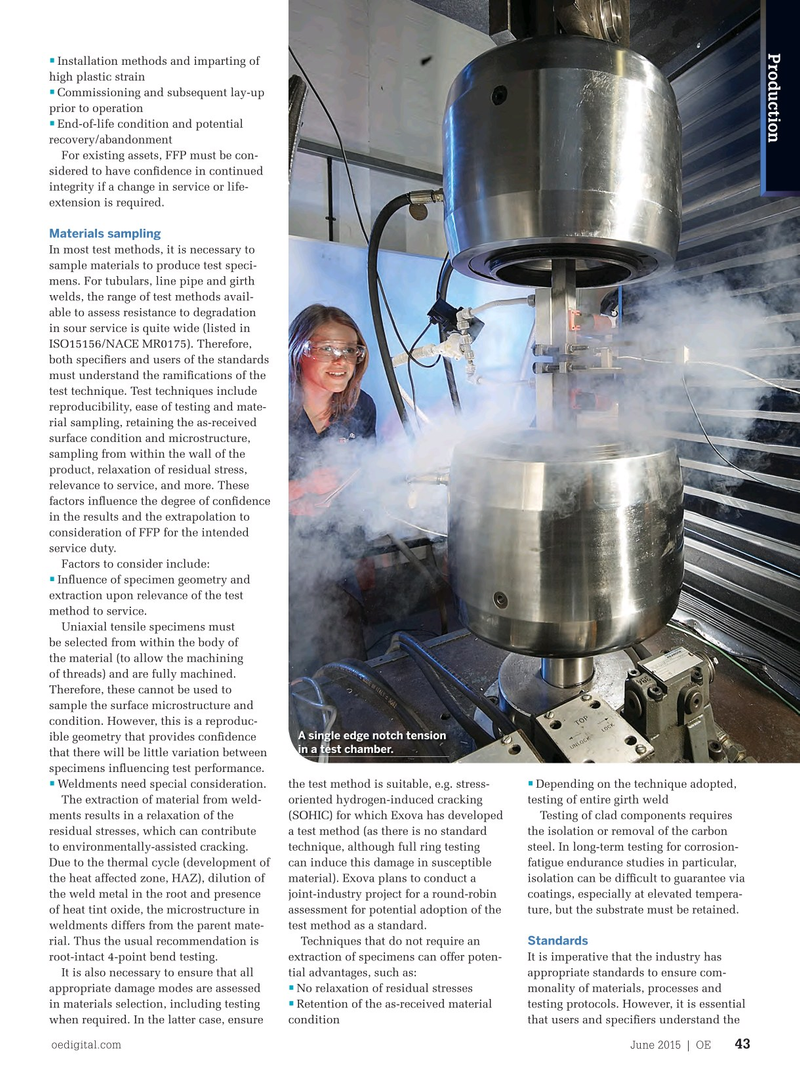
Page 41: of Offshore Engineer Magazine (Jun/Jul 2015)
Read this page in Pdf, Flash or Html5 edition of Jun/Jul 2015 Offshore Engineer Magazine
EyebrowProduction • tests in simulated service conditions. Installation methods and imparting of
Such tests can ensure safe materials high plastic strain • selection while avoiding excessive con- Commissioning and subsequent lay-up servatism in testing that could potentially prior to operation • eliminate good candidate materials. End-of-life condition and potential
During the past two decades, deepwater recovery/abandonment and ultra-deepwater developments have
For existing assets, FFP must be con- driven the need to assess the corrosion- sidered to have con? dence in continued fatigue performance of steel catenary risers integrity if a change in service or life- (SCRs) in mild sour conditions as well as extension is required. the impact of the external seawater envi-
Materials sampling ronment with cathodic protection. More
In most test methods, it is necessary to recently, the corrosion-fatigue behavior in sample materials to produce test speci- sweet produced ? uids and the effects of mens. For tubulars, line pipe and girth lateral buckling have been addressed.
However, in these cases, the vast major- welds, the range of test methods avail- ity of endurance testing has been per- able to assess resistance to degradation formed under ambient pressure and has in sour service is quite wide (listed in been limited to maximum test tempera- ISO15156/NACE MR0175). Therefore, tures of around 80°C. Some endurance both speci? ers and users of the standards testing of wires for ? exibles, plus fatigue must understand the rami? cations of the crack propagation and frequency scan- test technique. Test techniques include ning, has been undertaken at elevated reproducibility, ease of testing and mate- temperature and pressure by Exova. rial sampling, retaining the as-received
Now industry professionals need to surface condition and microstructure, consider how clad systems can be tested sampling from within the wall of the using elevated temperature and pressure. product, relaxation of residual stress,
In addition, high-pressure, high-tempera- relevance to service, and more. These ture (HPHT) developments could further factors in? uence the degree of con? dence drive corrosion-fatigue testing – even for in the results and the extrapolation to components such as downhole tubulars consideration of FFP for the intended and wellhead equipment. service duty.
Factors to consider include:
In? uence of specimen geometry and
Proactive ? tness for purpose (FFP) •
During the initial design phase, mate- extraction upon relevance of the test rials selection for subsea umbilicals, method to service.
risers and ? owlines (SURF) components Uniaxial tensile specimens must can be predicated upon knowledge of be selected from within the body of suitability from ? eld conditions or, in the material (to allow the machining borderline cases, a desire to test materials of threads) and are fully machined. to optimize selection. Testing is required Therefore, these cannot be used to to qualify materials and weldments for sample the surface microstructure and proactive ? tness for purpose (FFP) for condition. However, this is a reproduc-
A single edge notch tension new developments, which extend the ible geometry that provides con? dence in a test chamber.
material’s application to higher pressures that there will be little variation between and temperatures. Sometimes tests are specimens in? uencing test performance.
• • undertaken early, using non-project spe- Weldments need special consideration. the test method is suitable, e.g. stress- Depending on the technique adopted, ci? c material to avoid later dif? culties. The extraction of material from weld- oriented hydrogen-induced cracking testing of entire girth weld
Aspects to consider include: ments results in a relaxation of the (SOHIC) for which Exova has developed Testing of clad components requires
Mechanical properties and tolerable residual stresses, which can contribute a test method (as there is no standard the isolation or removal of the carbon • ? aw sizes for installation to environmentally-assisted cracking. technique, although full ring testing steel. In long-term testing for corrosion-
Material resistance to degradation (e.g. Due to the thermal cycle (development of can induce this damage in susceptible fatigue endurance studies in particular, • corrosion), environmentally assisted the heat affected zone, HAZ), dilution of material). Exova plans to conduct a isolation can be dif? cult to guarantee via cracking and corrosion fatigue the weld metal in the root and presence joint-industry project for a round-robin coatings, especially at elevated tempera-
Operational conditions and changes of heat tint oxide, the microstructure in assessment for potential adoption of the ture, but the substrate must be retained. •
Predicted upset or intermittent weldments differs from the parent mate- test method as a standard.
•
Standards conditions rial. Thus the usual recommendation is Techniques that do not require an
These factors then in? uence the mate- root-intact 4-point bend testing. extraction of specimens can offer poten- It is imperative that the industry has rial selection, which is based on: It is also necessary to ensure that all tial advantages, such as: appropriate standards to ensure com-
Environmental conditions, mechanical appropriate damage modes are assessed No relaxation of residual stresses monality of materials, processes and • • • properties and compatibility with other in materials selection, including testing Retention of the as-received material testing protocols. However, it is essential materials when required. In the latter case, ensure condition that users and speci? ers understand the oedigital.com June 2015 | OE 43 042_OE0615_Prod Ops1_H2S.indd 43 6/1/15 2:19 PM

 40
40

 42
42